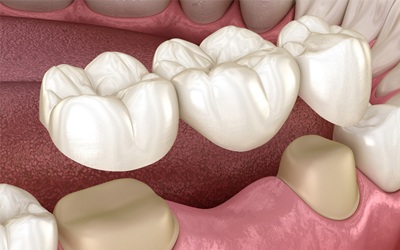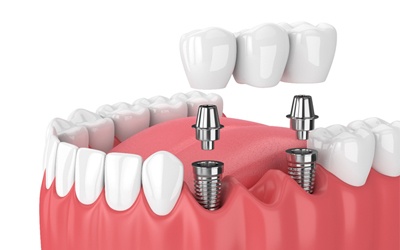
Multiple Tooth Implants
Covering the Gaps in Your Smile For Good

There are multiple parts to a tooth, but if you were to ask a non-dental professional, they would probably say a tooth consists of a crown and a root. So, when a tooth falls out or is extracted, it should be replaced in its entirety, correct? Many patients opt for the “look” of a fully restored smile, but not a complete restoration. Only with a dental implant can you restore the tooth structure. Whether it is one, multiple, or all your teeth that are missing, an implant-retained dental prosthetic is a superior solution to tooth replacement. Learn more about this unique and effective procedure by calling our office and scheduling an appointment today.
Non-Implant Tooth Replacement Options

There are multiple non-surgical options available should you decide that a more non-invasive approach is right for you:
- Dental Crowns and Bridges – Using your healthy teeth as anchors, your dentist will file down these teeth to ensure the dental crowns properly fit over them. Once your bridge is ready, the three crowns that will be fused together are put into place with the middle crown sitting on top of your gums, recreating the look of a restored smile.
- Partial Dentures – If you have multiple missing teeth along an arch, but they may not be consecutive, you can find a solution with a partial denture. Using artificial teeth situated on a gum-colored base, the device will be secured in your mouth with the help of clips that will attach to your natural teeth. It works very much like a puzzle piece.
- Full Dentures – If all teeth are missing, whether it is an entire top arch or bottom arch, full dentures can offer a safe and reliable solution. Complete with artificial teeth on a natural-color base, these will sit on top of your gums and require your natural suction to hold them in place.
The Dental Implant Process

The process for receiving an implant-retained dental prosthetic can take several months, so it’s important not to try and rush it, as certain steps must be thoroughly completed before moving on to the next step.
When having implants placed, Dr. Shahdad and a local oral surgeon will work to ensure the process runs smoothly and with no complications. The procedure is performed in phases with the first being the “preparation” phase. During your initial consultation, Dr. Shahdad will examine your smile to determine if you are a qualified candidate. Then, she will take digital images of your smile to determine the proper placement of the implants. Additionally, these images will serve as a blueprint for lab technicians to begin crafting your custom prosthetic.
During the second phase, the oral surgeon will administer anesthesia before making an incision in the gums and carefully positioning and placing the implants. Your dentist will determine how many implants you will need, based on the number of teeth missing. Once the dental implants are in place, you will go home to heal. This part is very important, as osseointegration must occur in order for dental implant placement to be successful. The implants will fuse to the bone and surrounding tissues, offering a more stable foundation for the restoration.
Finally, you will return to our office to have the abutments and customized implant-retained prosthetic (i.e. implant bridge or implant-retained dentures) put into place.
Benefits of Implant-Retained Dental Prosthetics

- You’ll have greater stability because of the surgical placement.
- Your confidence levels will rise as a result of your implants. A complete smile makes a person look and feel better about themselves.
- Chewing, eating, and speaking will not be a problem with an implant-retained prosthetic.
- Your multiple teeth implants will last much longer than a traditional bridge and crown restoration. In fact, it can last decades or more.
- There will be no need to worry about changes in your facial structure because your implants will continue to stimulate your jawbone, preventing bone and tooth loss, as well as alignment problems and facial sagging.